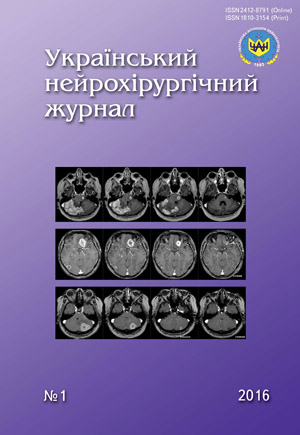Clinical and neurological predictors of outcome in the acute phase of cerebellar hemorrhage
DOI:
https://doi.org/10.25305/unj.61886Keywords:
cerebellum hemorrhage, outcomeAbstract
Objective: To study new data about clinical and neurological predictors of outcome in the acute phase of cerebellar hemorrhage.
Materials and methods: We analyzed the data of the clinical-neurological examination and the results of the treatment of 95 patients with cerebellum hemorrhage (CH) in the acute phase.
Results: According to the Glasgow Outcome Scale (GOS) favorable outcome was in 55 (57.9%) patients, poor — in 12 (12,6%) and fatal — in 28 (29,5%) (5–4, 3–2 and 1 points). We showed significant difference with respect to the level of consciousness according to the Glasgow Coma Scale (GCS) (p=0,000), systolic blood pressure (p=0,013), lesion of the cranial nerves (p=0,000), movement disorders (p=0,008), Babinski reflex (p=0,001), sensitivity disturbance (p=0,001) and pelvic organ dysfunction (p=0,000).
Conclusions. GCS score of greater than 13 points, normal flexor plantar response and absence of cranial nerves lesion are strong predictive factors of favorable outcome.
References
1. Lekic T, Rolland W, Hartman R, Kamper J, Suzuki H, Tang J, Zhang JH. Characterization of the brain injury, neurobehavioral profiles, and histopathology in a rat model of cerebellar hemorrhage. Experimental Neurology. 2011; 227(1):96-103. [CrossRef] [PubMed]
2. Pong V, Chan KH, Chong BH, Lui WM, Leung GK, Tse HF, Pu JK, Siu CW. Long-term outcome and prognostic factors after spontaneous cerebellar haemorrhage. Cerebellum. 2012; 11(4):939-45. [CrossRef] [PubMed]
3. Li Q, Qin XY, Zhang JH, Yang J. Prognosis study of 324 cases with spontaneous intracerebral hemorrhage in Chongqing. Acta Neurochirurgica Supplement. 2011; 111:399-402. [CrossRef] [PubMed]
4. Zhang J, Wang L, Xiong Z, Han Q, Du Q, Sun S, Wang Y, You C, Chen J. A treatment option for severe cerebellar hemorrhage with ventricular extension in elderly patients: intraventricular fibrinolysis. Journal of Neurology. 2013; 261(2):324-9. [CrossRef] [PubMed]
5. St Louis EK, Wijdicks EF, Li H, Atkinson JD. Predictors of poor outcome in patients with a spontaneous cerebellar hematoma. Canadian Journal of Neurological Sciences. 2000; 27(1):32-6. [PubMed]
6. Murashko AA. Hirurgicheskoe lechenie gipertenzivnyh gematom mozzhechka [Surgical treatment of hypertensive cerebellar hematomas] [dissertation]. Moscow: N.V. Sklifosofskiy Emergency Care Institute; 2010. Russian.
7. Goncharuk OM. Struktura spontannykh krovovylyviv u zadnyu cherepnu yamku [The Structure of Spontaneous Hemorrhage in Posterior Cranial Fossa]. Mizhnarodnyy nevrolohichnyy zhurnal. 2010; 3(33): 188-90. Ukrainian.
8. Dammann P, Asgari S, Bassiouni H, Gasser T, Panagiotopoulos V, Gizewski ER, Stolke D, Sure U, Sandalcioglu IE. Spontaneous cerebellar hemorrhage - experience with 57 surgically treated patients and review of the literature. Neurosurgical Review. 2011; 34(1):77-86. [CrossRef] [PubMed]
9. Ballance HA. Case of traumatic haemorrhage into the left lateral lobe of the cerebellum, treated by operation, with recovery. Surg Gynecol Obstet.1906; 3: 223-225.
10. Wu YT, Li TY, Chiang SL, Chu HY, Chang ST, Chen LC. Predictors of first-week mortality in patients with acute spontaneous cerebellar haemorrhage. Cerebellum. 2013; 12(2):165-70. [CrossRef] [PubMed]
11. Matsukawa H, Shinoda M, Fujii M, Takahashi O, Yamamoto D, Murakata A, Ishikawa R. Relationships among hematoma diameter, location categorized by vascular territory, and 1-year outcome in patients with cerebellar hemorrhage. World Neurosurgery. 2012; 77(3-4):507-11. [CrossRef] [PubMed]
12. Wu YT, Li TY, Lu SC, Chen LC, Chu HY, Chiang SL, Chang ST. Hyperglycemia as a predictor of poor outcome at discharge in patients with acute spontaneous cerebellar hemorrhage. Cerebellum. 2012; 11(2):543-8. [CrossRef] [PubMed]
13. Donauer E, Loew F, Faubert C, Alesch F, Schaan M. Prognostic factors in the treatment of cerebellar haemorrhage. Acta Neurochir (Wien). 1994; 131(1-2):59-66. [CrossRef] [PubMed]
14. Kobayashi S, Sato A, Kageyama Y, Nakamura H, Watanabe Y, Yamaura A. Treatment of hypertensive cerebellar hemorrhage — surgical or conservative management? Neurosurgery. 1994; 34(2):246-50" target="_blank">[CrossRef] [PubMed]
15. Fujii Y, Takeuchi S, Sasaki O, Minakawa T, Tanaka R. Stroke. 1998; 29(6):1160-6. [CrossRef] [PubMed]
16. Dolderer S, Kallenberg K, Aschoff A, Schwab S, Schwarz S. Long-term outcome after spontaneous cerebellar haemorrhage. Eur. Neurol. 2004;52(2):112-9. [CrossRef] [PubMed]
17. Tokimura H, Tajitsu K, Taniguchi A, Yamahata H, Tsuchiya M, Takayama K, Shinsato T, Arita K. Efficacy and safety of key hole craniotomy for the evacuation of spontaneous cerebellar haemorrhage. Neurol Med Chir (Tokyo). 2010; 50(5):367-72. [CrossRef] [PubMed]
18. Fodstad H, Kelly PJ, Buchfelder M. History of the cushing reflex. Neurosurgery. 2006; 59(5):1132-7. [CrossRef] [PubMed]
Downloads
Published
How to Cite
Issue
Section
License
Copyright (c) 2016 Konstantin Kondratyuk, Anatoliy Son

This work is licensed under a Creative Commons Attribution 4.0 International License.
Ukrainian Neurosurgical Journal abides by the CREATIVE COMMONS copyright rights and permissions for open access journals.
Authors, who are published in this Journal, agree to the following conditions:
1. The authors reserve the right to authorship of the work and pass the first publication right of this work to the Journal under the terms of Creative Commons Attribution License, which allows others to freely distribute the published research with the obligatory reference to the authors of the original work and the first publication of the work in this Journal.
2. The authors have the right to conclude separate supplement agreements that relate to non-exclusive work distribution in the form of which it has been published by the Journal (for example, to upload the work to the online storage of the Journal or publish it as part of a monograph), provided that the reference to the first publication of the work in this Journal is included.









